Analysis of genome plasticity in pathogenic and commensal Escherichia coli isolates by use of DNA arrays
- PMID: 12618447
- PMCID: PMC150128
- DOI: 10.1128/JB.185.6.1831-1840.2003
Analysis of genome plasticity in pathogenic and commensal Escherichia coli isolates by use of DNA arrays
Abstract
Genomes of prokaryotes differ significantly in size and DNA composition. Escherichia coli is considered a model organism to analyze the processes involved in bacterial genome evolution, as the species comprises numerous pathogenic and commensal variants. Pathogenic and nonpathogenic E. coli strains differ in the presence and absence of additional DNA elements contributing to specific virulence traits and also in the presence and absence of additional genetic information. To analyze the genetic diversity of pathogenic and commensal E. coli isolates, a whole-genome approach was applied. Using DNA arrays, the presence of all translatable open reading frames (ORFs) of nonpathogenic E. coli K-12 strain MG1655 was investigated in 26 E. coli isolates, including various extraintestinal and intestinal pathogenic E. coli isolates, 3 pathogenicity island deletion mutants, and commensal and laboratory strains. Additionally, the presence of virulence-associated genes of E. coli was determined using a DNA "pathoarray" developed in our laboratory. The frequency and distributional pattern of genomic variations vary widely in different E. coli strains. Up to 10% of the E. coli K-12-specific ORFs were not detectable in the genomes of the different strains. DNA sequences described for extraintestinal or intestinal pathogenic E. coli are more frequently detectable in isolates of the same origin than in other pathotypes. Several genes coding for virulence or fitness factors are also present in commensal E. coli isolates. Based on these results, the conserved E. coli core genome is estimated to consist of at least 3,100 translatable ORFs. The absence of K-12-specific ORFs was detectable in all chromosomal regions. These data demonstrate the great genome heterogeneity and genetic diversity among E. coli strains and underline the fact that both the acquisition and deletion of DNA elements are important processes involved in the evolution of prokaryotes.
Figures


References
-
- Behr, M. A., M. A. Wilson, W. P. Gill, H. Salamon, G. K. Schoolnik, S. Rane, and P. M. Small. 1999. Comparative genomics of BCG vaccines by whole-genome DNA microarray. Science 284:1520-1523. - PubMed
-
- Bergthorsson, U., and H. Ochman. 1998. Distribution of chromosome length variation in natural isolates of Escherichia coli. Mol. Biol. Evol. 15:6-16. - PubMed
Publication types
MeSH terms
Substances
Associated data
- Actions
LinkOut - more resources
Full Text Sources
Other Literature Sources
Molecular Biology Databases
Research Materials

